

 |
Japan 2004 |  |
|
The Geijin returns after 13 years
To really understand a country one must visit its McDonald’s. Of course I fully subscribe to the ‘Supersize Me’ agenda that proscribes visits to the demonic purveyor of cardboard nutrition. One visit in a lifetime is one visit too many; nevertheless for the cultural gourmand it gives a clue to popular tastes not to be found in museums or galleries. Nothing can sum up the UK better than its McDonalds’s. MacDonald’s is the fast food king of acculturation. Across the world it has adapted itself to local tastes, in France they serve Crevette Salade, in Singapore we even have congee (though who in their right mind would go to MacDonald’s for congee). Every nation has imprinted their culture into MacDonald’s in some way, except the UK; put simply MacDonald’s took one look at the UK and realized there was no need to include aspects of UK culture because there was none to include and even if they bothered nobody in England could tell them what UK culture was. No Fish and Chips or Toad in the Hole was required. They simply delivered a watered down version of the American version, with no free refills. The Japanese version is however utterly Japanisised and jolly nice it is too. As I chomped on my teriyaki burger (I succumbed yes I am weak, but it was research), I reflected on the observations in Alex Kerr’s book ‘Lost Japan’ at how anything from abroad has to be Japanified before it can be accepted and appreciated in the home islands. Even the gaudy red and white logo seemed wholly in place, positively reserved and tasteful, compared to the love of lurid colour displayed in Japan, which reaches its apotheosis in the Pachinko halls. This McDonald’s felt like a poor man’s Mosburger and I had no images of freeways in Tampa Bay when I munched in Mitaka; the Americana was replaced by Mikado. What could the Japanese do with White Castle? Mr Kerr’s fabulous paean to a Japan lost forever, one that comes from a mixture of influences from Korea, China and further south in Polynesia (his thesis, I did not see it myself I confess), acted as a backdrop to my return to the beginning after thirteen years. The beginning as Japan was the first Asian country I visited back in 91 during the coup that ended Gorbachov and the build up to first Iraq war; hmm whatever happened to that Hussein character? Back then Japan felt like a futuristic novel, it felt so advanced it made London appear positively bucolic. Thirteen years on it has not changed, it even seems a little frayed at the edges. Amazingly one can hardly use a credit card in Japan; it is mostly still cash based and for a Singaporean that is positively ante-diluvian. Thirteen years of stagnation have taken their toll on the place, and no doubt the people. The decision to go back to Japan after so long was one that I postulated upon all summer, in contact with Kentaro, my friends at SCB Tokyo and brother William the idea germinated and grew till by September I had to go there. I have not revisited places that often, though when I leave them I always want to go back. When I am about to croak old and grey I will still be listing all the places I want to visit or return to, and worse I will delude myself I still can. For a change I decided to spend a couple of nights in hotels at the start to spend a little while in central Tokyo before going up to Kichijoji, which is far nicer than central Tokyo. As I slept my first night in Japan I realised I spent my first day in Tokyo entirely indoors and underground. From airport to train to subway to hotel to subway to restaurant to hotel I never had to make one step uncovered. In central Tokyo the weather is truly irrelevant, it acts simply as a tableau to peer at through double glazing, a conversation piece as one dines looking out from the 22nd floor at the rain and wind outside, one might as well be in Antarctica or under the ocean, the weather is estranged from reality, just as everything natural in separated from reality in modern Japan. So different from the inspiration behind those famous Japanese prints of the past where the elements completely dictated survival. This occurred to me as I ate my cuttlefish and Hokkaido delicacies high in the Tokyo sky in some faceless and nameless urban tower block (no real sky-scrappers as such in Tokyo but a lot of tower blocks) on the first evening of the trip. The new connections have made the journey from Narita to Tokyo more palatable than my previous journey in 1991. In 1991 I had flown Aeroflot and changed in Moscow but it was the Narita to Tokyo leg that was burned into my brain as intolerably long and slow. Perhaps because it was the last stage but the train journey appeared to dwarf the 17-hour flight time. Now one just sits on a tube train from Narita and gets to Shinjuku in just over an hour. A chance to take in the Tokyo scenery, two parts of which really stuck in my brain, one was a mural of the Beatles and one the captivatingly entitled Ritchie Blackmore cafe. These two pieces of street signage re-enforced my happiness at being back in a country where music existed before 1997 and where Barbie Girl is a forgotten piece of Eurotrash not a tune endlessly played in utterly un-ironic discos (Singapore take a bow). I mean how many other Ritchie Blackmore cafes can there be in the world, only, only, only in Tokyo! Which of course is why I love Tokyo. But I digress, the Villa Fontaine Roppongi is a nice enough hotel, though for the same money what one can get in Singapore may move one to tears. My view of the air conditioning units outside my window allowed for quiet contemplation before meeting my esteemed colleague Makiko and her friend Madoka in Roppongi for drinks and a large tub of tofu which is apparently a Hokkaido delicacy (hmmm). I spent my first full day strolling around the intriguing Azabu-Juban, which is a haven of old Tokyo just below the glitz and ‘glamour’ of the concrete jungle around Roppongi. Tokyo suffered terribly in the war, in the film ‘Fog of War’ it mentions over 50% destruction in one raid. When it was re-built metropolitan Tokyo lost a lot of charm and only a few pockets of raffish boheme remain. I was lucky enough to wander through two such areas, Azabu-Juban and the area around the University. Any tourist in Tokyo should look to these districts as an alternative to Ginza, Shinjuku, Roppongi and the rest of the bright lights big city snares. When in one cafe in Asabu-Juban I had the unique experience of having to request chop-sticks with my meal. My attempts to simulate chopsticks using a fork and spoon drew blank looks from a very confused waitress; after trying out various implements I was saved by another patron who had observed my plight and interjected, leading to much giggling from said waitress and most of the cafe. A day wondering around, eighty percent of the time quite lost, is usual traveller fare is Tokyo. What was unusual was my evening at the pork restaurant in Ginza. This lucky traveller was escorted by Madoka and five of her good friends to a restaurant that specialised in every kind of pork dish one could conceive of. Considering the quality of the food and the locale the price was OK. It pays to have friends in Tokyo. After two nights in deepest Roppongi and two breakfasts of strange but tasty mini sausages I was eager to get out to Kichijoji and closer to the ‘real’ Tokyo, which is found in the suburbs. Missed by most travellers it is suburbs such as Kichijoji that have more character than the heaving central locales. The same is true of London where Hampstead, Notting Hill, Camden. Crouch End and other areas provide a pleasant counter-point to the hell of Oxford Street and the City. Of course I had the advantage of staying in Kentaro’s mansion and that is the sort of luxury accommodation money cannot buy in Tokyo. On top of this there is Sumiko’s wonderful cooking; all in all I was very well looked after and just as in 91 it gives me an advantage over normal visitors who have to struggle with hotels and restaurants and see precious little of day to day Japanese life. One essential Japanese experience is the Fugu dinner, available at specialist restaurants. Having a Fugu dinner is just the sort of ‘Clive James postcard from Japan’ experience that actually real travellers never really do. Akin to singing Danny Boy in a Karaoke bar downtown to applause from slightly sloshed salary men. However for your very own ‘I am Clive James me’ experience forking out for a Fugu dinner is well worth it. The fish, as everyone knows, is poisonous. But happily only in large quantities; giving rise to the story of the man who whilst waiting for his friend could not resist tucking in, only to end up eating two person’s worth and promptly keeling over. Never be late for a Fugu dinner. The food was lovely, people say it does not taste of much but it has a lovely texture and absorbs flavour from the various ways it is prepared. It is also wonderfully fresh; the body parts of the fish were still twitching when brought to our table. For the complete Kichijoji experience (Kichi is the Camden of Tokyo) we popped along to the Jazz club ‘Sometime Kichijoji’ and saw a decent American jazz band and were entertained by the young lady who fell fast asleep at the front table (Sunday night in Tokyo is a time for rest whatever the background) much to the amusement of the band leader. Sometimes even Jazz cannot revive a poor tired salary girl. Tokyo has a reputation for being very expensive but generally if one is careful it is not that bad, only when one lets ones guard down does one get stung. This happened to me when making my way from the University to the National Museum on a wet Sunday afternoon, stopping for some street food I ate some sausages, fish balls and other skewers from a street vendor who promptly charge me about 17 USD in Yen! The most expensive street food I’ve ever had, even worse than the sausage sellers in Leicester Square. No matter because the museum was a treat, especially as they had opera singers on the stairs giving a recital when I arrived. They sang Japanese folk tunes but also gave a rounding rendition of Amazing Grace, which for some reason sounded far louder. This must be because either it is easier to belt out songs in English than in Japanese or my Western ears are more attuned to English so words in English immediately sound louder and clearer. I must admit the recital is my abiding memory of the museum, oh and the amazingly tasty ice cream available at the vending machines. But I am a big fan of the early Japanese art that was featured in the museum. This art is lovingly described in ‘Lost Japan’ (which talks at length of Polynesian roots). The museum also referred to the heavy Korean influences in early Japan, which remains a politically sensitive topic. Tokyo was all about Jazz, food, meeting people and going out; t’was a proper Clive James experience. Which makes sense as I am getting closer to Clive’s age than the age I was when I first went East. In fact I am probably closer to Alan Whicker now! Oh and another O’Brien turned; lucky old Tokyo waits thirteen years for one and then two come along at the same time. The big bad Billy hit town on Monday and on Tuesday I took him down to Takodanababa for Cambodian food (in Tokyo, would you Adam and Eve it) and some company. It was a nice easing into the Tokyo scene before he and I headed down to the town of Golden Pagodas, Zen temples and Geisha Girls (not that we saw any, sigh). The biscuit tin Japan we grow up with. The one that looks nothing like 90% of Japan. Our journey started on the World Famous Shinkansen; the bullet train that was, and I think may still be, the last word in train travel. Just the name bullet train evokes images of a white streak flashing past the foot of Mount Fuji and taking the bullet is one big tick on my ‘been there & done that’ list. The journey itself was uneventful aside from the lovely warm green tea in space age bottles that they served; truly cool. Oh and sadly we did not see Mount Fuji, we were possibly on the wrong side of the train for that. We had a room booked in a hostel, Uno House, which was a cheap 40 USD a night for two, a real bargain in pricey Kyoto. Basic of course but a convivial place and we met travellers from around the world there; rather a different atmosphere to the business hotels of Roppongi. We first ventured from the hostel out to Nanzen-ji one of the principle must-sees in a town stuffed full of must-sees. The temple is famous for its large Sanmon, entry gate, which is high enough to afford some excellent views of the city. We also took the chance to have a cup of tea in the traditional zen garden. We explored the site and in looking for one sub-temple named ‘Oku-no-in’ we ended up in another ‘attraction’ next door, an extra-ordinary Edwardian garden that seemed to have been the ‘folly’ of a local magnate. How we ended up there I am not quite sure but there are quite a lot of peculiar places to chance upon in the woods around Kyoto. We eventually made it to the Oku-no at dusk and proceeded down into Kyoto as night fell. Except on the Eastern tip as we were we were not sure how to walk back. After an interesting exploration of side streets and alleys we eventually found the tube. On our way we chanced upon the Kyoto International centre; a haven for weary travellers with loos, internet terminals and comfortable sofas. Just what we needed after a long day! The evening we went to one of the most popular restaurants for budget travellers Ganko Zushi, which was nice but a far cry from the famous Kaiseki haute Japanese cuisine, which sadly we did not get to try. I did get to amuse the chef by remarking ‘mai yu’ on his food. In fact that particular phrase went down rather well everywhere. Lost Japan devotes a whole chapter to Kyoto. How Kyoto hates itself and is eating itself; all starting with the building of the ugly tower. Kyoto wants to be Tokyo, which is ironic because most people who love it are very glad it is not Tokyo! Alex Kerr lovingly opens the lid on hidden Kyoto in his book, describing how it takes 18 years to enter one restaurant (they have to know you are a good sort see). How when a Kyoto-ite asks you if you would stay and have bubzuke (tea on rice) it is time to leave; how you must drink half a cup of tea to make the right impression. Drink it all and they shall moan and leave it all and they shall moan twice as hard. The Kyoto artists and literati he describes are too far removed from anything a traveller (even Sir Clive himself) could ever experience. Yet the book added colour to my impressions and understanding of that extra-ordinary city. The next day William and I ventured into the heart of Zen, the most famous Japanese Zen temples of Ryoan Ji and Daitoku-ji (Zen temples brought to us care of Hitachi) and the world famous (thanks to the novel) Kinkaku-ji. On a glorious sunny morning the temples of Kyoto’s northwest were particularly captivating, even though the hot sun took something out of we two tourists. The setting of Northwest Kyoto close to the outskirts of town with the countryside in view is such a refreshing change to the Bladerunner backdrop of downtown Tokyo. The Zen temples of Daisin In should be peaceful areas of contemplation and reflection but as lovingly described in lost Japan, the appalling soundtrack booming from the speakers does rather crash through the mood. Why don’t they just play J-pop and have done with it? Even a Geijin like me can see the incongruity of the location and experience yet it does not seem to bother the temple masters. It makes me wonder what is the meaning of Zen in modern Japan. What is the meaning of ancient Japan in modern Japan? Can you imagine a loud soundtrack booming around St Paul’s for the ‘benefit’ of tourists? The golden temple of Kinkaku-ji was crowded but well worth a trip, the way it catches the sun and reflects in the water is an image that stays with one forever; much as I am sure the temple’s founders knew it would. The current temple of course has been rebuilt after a crazed monk burnt it down in 1950, which was the inspiration for Mishima’s ‘The Golden Pavillion’. The webpage http://www.jref.com/practical/kinkakuji.shtml has a short bit amount the monk but I long to find out more; perhaps I should start with reading the novel. William and I then decided to hot-foot it from the Northwest all the way across town and up Mount Hei. The trip involved taxi, train, cable-car and on foot hiking before we reached the sacred mount overlooking the city. It is arguable that the most fun part was the cable car as the views were spellbinding as we went up the mountainside. The Enrakyu-ji founded in 788 was the central attraction in terms of historical importance and though not as impressive as what is in Kyoto itself the temple has a special rarefied atmosphere removed as it is from the city far below. We also enjoyed ringing the large bell, which we did perhaps rather too often given our combined age. That night William and I met up with other travellers in the hostel and we shared stories of Tokyo, Kyoto and more importantly for us other places we had not been to. For me the holiday was nearly over but for Will it was just beginning. The next day was my last full day in Japan and after a fraternal dispute about the lockers in Kyoto station we headed to Nijo jo a castle and different to the monasteries and temples we had seen thus far. The guidebooks all touch on it but William and I felt it was a ‘must see’ and all round the best site in Kyoto. The fantastic Shogun castle is straight out of a Ninja film complete with squeaky nightingale floor (they squeak so no one can sneak up on you) and concealed chambers where the Shogun’s bodyguards could hide in case. The walls are decorated with spectacular screen paintings from the tea master and landscape artist Kobori Enshu. It is a splendid castle and well worth a trip. There are no rock and sand gardens to help one contemplate the navel of the world but I would say one can take a break from inestimable nothingness (mu) from time to time. Time for a splendid Suki Yaki in Kichijoji at the end of my holiday, something that took me right back to 1991 and the first time I tried it. It had been a thirteen-year gap and Japan had aged just like me. It is not quite as wild eyed and as it was at the height of the boom but Japan still offers so much to see and do. There was one last adventure of the way to my last supper. The final frontier for any traveller is always the busses. One can negotiate tubes, taxis and on foot without too much trouble, but busses, that is the acid test. Making my way across the Tokyo suburbs required me to take a bus from Kichijoji station and my big mistake was not writing down the name of the stop I wanted. So when I found the right bus I stated clearly where I thought I wanted to go only to be starred at blankly. I repeated the word I had tried to memorise a few times only for the bus driver to become increasingly confused. But helpful as he was he would not drive on until he was sure I was in the right direction. The conversation carried on whilst a packed bus waited. After a few minutes one helpful passenger who spoke English tried to help but he had no idea where I was going either. By now the bus driver was out of his seat in the bus having a three-way conversation between me and the other passenger. Conscious of delay I was causing I told the bus drive to carry on and we would chance it. A few minutes into the journey I had a little idea. I asked the helpful passenger if I could borrow his dog and bone, he obliged and I called Sumiko and asked her to speak to him, a small chat later and he told me it was the next stop. Sorted. If I had not visited Japan in 1991 I probably would not be in Asia now. I had never imagined myself living anywhere but Japan in Asia. For those of us young in the 80s Japan was Asia. Now the old Zen master is being upstaged by brash new Asian tigers, especially the cultural father to the West, the Sino-behemoth that threatens to swamp Asia and dominate the cultural and political geography of the region in this 21st Century. I live in a Chinese country and more and more Geijin are coming East to the Chinese world and not to Japan. This illustrates a transformed landscape from the 80s, the Nikkei, Clive James, Karaoke and all that. Japan has to re-invent itself but people have said that since 1991 and whilst quarters of Japanese society and business have done so it takes a lot more pressure to move the centre. If the Second World War did not change Japanese society can the rise of Sino-Asia do it? Or will the cosiness that Alex Kerr laments in his book as bedevilling Japan, prevent anything from really changing and will Japan continue to drift? Is Japan truly lost? Of course it is wrong to have one of the world’s great Zen temples sponsored by Hitachi, it should be Suzuki, or perhaps Kawasaki |
|
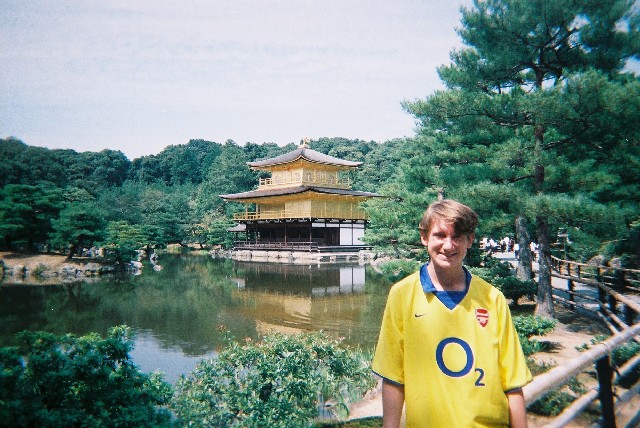 The Golden monkey in the Golden shirt outside the Golden temple |
|
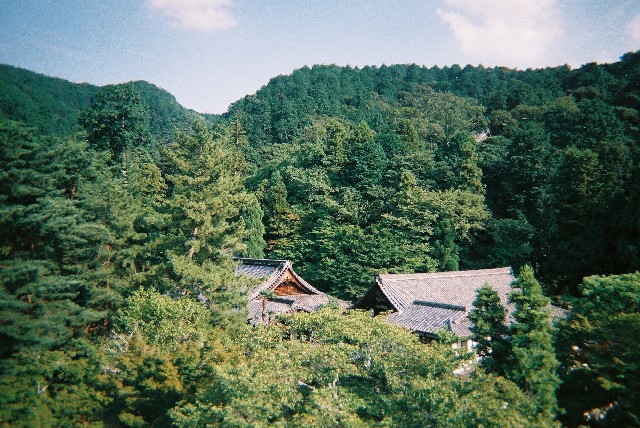 The hills of Kyoto, a refreshing change from Tokyo |
|
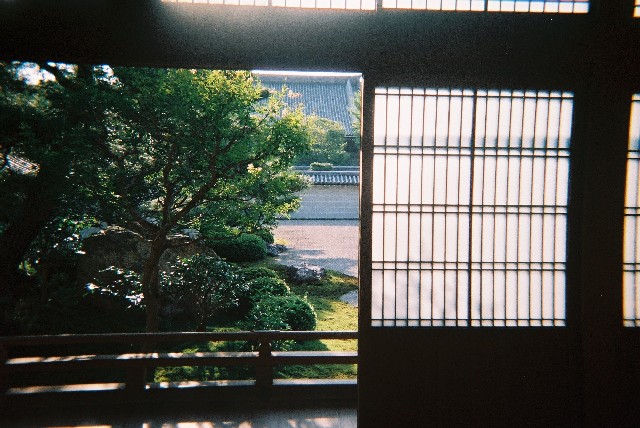 Inside a Zen Temple |
|
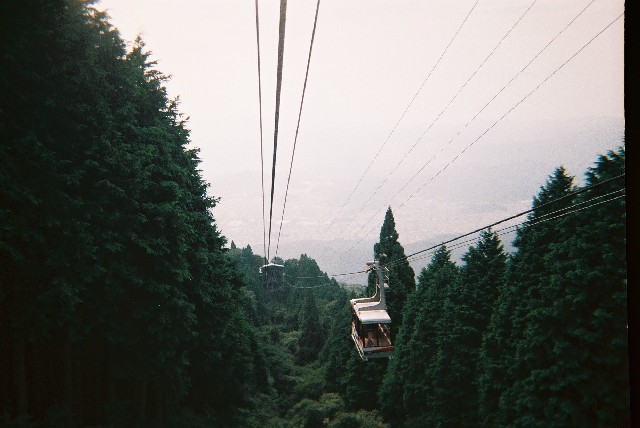 The Cable Car to Mount Hei |
|
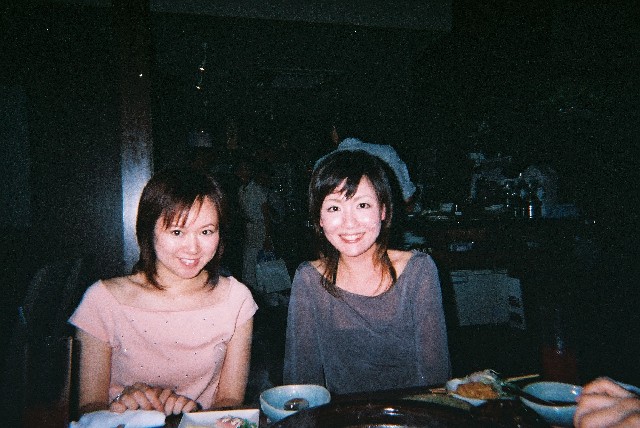 Dining out in Ginza |
|
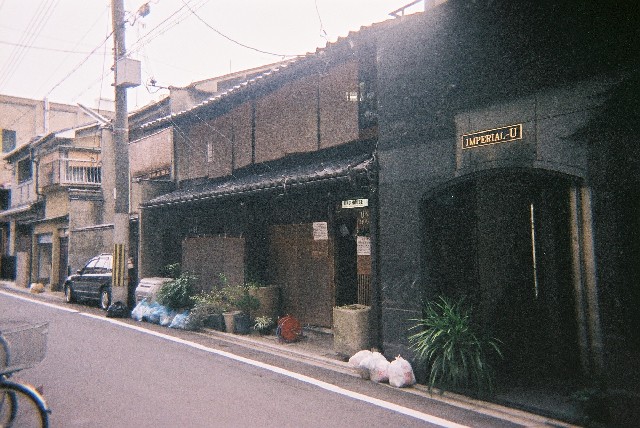 The Only place to stay darling |
|
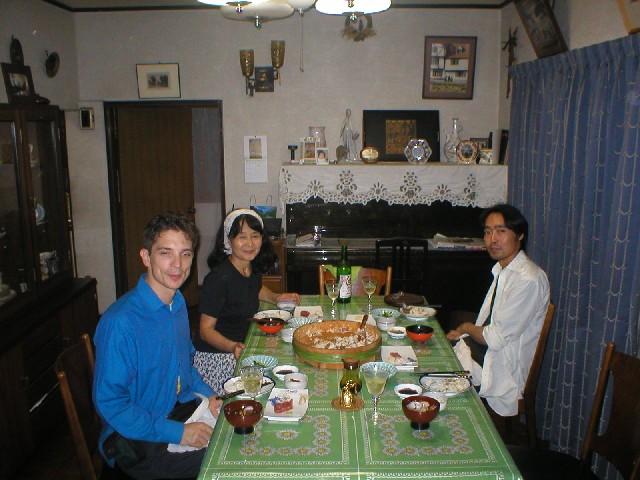 Dining in in Kichijoji |